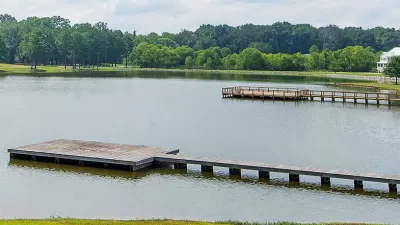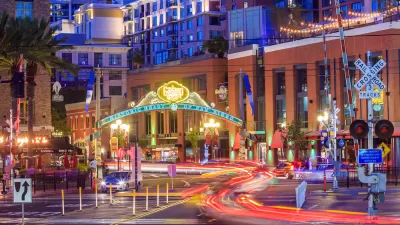If the market demand is there, why isn't more mixed-use housing getting built? Follow the money.
“This is the heart and the core, the very center of new urbanism, and it’s a difficult, messy, icky mess.”
What is Steve Maun, a developer and CNU board member, complaining about? Money, money, money. While planners and new urbanists have had their attention focused on changing zoning and coding to allow the sort of mixed-use buildings that people love, attracting financing for urbanism has remained a challenge.
The major roadblocks to financing the urban form that consumers increasingly prefer is not market demand, but decades-old government policies. The Federal Housing Administration (FHA), Fannie Mae and Freddie Mac, and HUD all have rules on the books that limit the percentage of a building that can be used for commercial space – if a federal mortgage is involved, that is. This obstructs the development of the key ingredient of traditional Main Streets; mixed use buildings with retail on the ground floor and apartments or condos above.
Maun explained all of this at a panel at CNU 21 in Salt Lake City (which can be seen in its entirety, below).
CNU and a consortium of partners, including the Regional Plan Association and the National Association of Home Builders, managed earlier this year to convince the FHA to change the limitations. “We’ve been to a lot of meetings in Washington, and you rarely get someone to lean across the table and say, ‘You know, you’re right,’” said Maun. “But this actually happened.” The revision is still officially pending, but the change in attitude is worth celebrating.
The remaining obstacle is entrenched thinking among banks and lenders. In the past, bankers considered a balance of income types in the same building as a benefit, not a drawback. Just as you balance your retirement accounts out by investing in a different investment types, having some income from housing and some from retail or office diversifies your portfolio. Today, however, mixed-use development doesn’t fit neatly into the standard real estate investment trust.
“We need to find new ways of securitizing and packaging these new loans into asset classes,” added Richard Oram, chairman of the Oram Foundation and a supporter of CNU’s efforts. “Making this happen is going to require new partnerships between Main Street and Wall Street, particularly between community banks and big banks.”
It will certainly help that the housing recovery seems to be fueled by more urban development. It was widely reported that housing starts were up 6.8% in May; what received less attention was the fact that single-family home construction was actually only up .03% -- the rest of that rise can be attributed to housing types with multiple units. The market will likely be the most convincing factor for change in the entire equation.

Planetizen Federal Action Tracker
A weekly monitor of how Trump’s orders and actions are impacting planners and planning in America.

Restaurant Patios Were a Pandemic Win — Why Were They so Hard to Keep?
Social distancing requirements and changes in travel patterns prompted cities to pilot new uses for street and sidewalk space. Then it got complicated.

Map: Where Senate Republicans Want to Sell Your Public Lands
For public land advocates, the Senate Republicans’ proposal to sell millions of acres of public land in the West is “the biggest fight of their careers.”

Maui's Vacation Rental Debate Turns Ugly
Verbal attacks, misinformation campaigns and fistfights plague a high-stakes debate to convert thousands of vacation rentals into long-term housing.

San Francisco Suspends Traffic Calming Amidst Record Deaths
Citing “a challenging fiscal landscape,” the city will cease the program on the heels of 42 traffic deaths, including 24 pedestrians.

California Homeless Arrests, Citations Spike After Ruling
An investigation reveals that anti-homeless actions increased up to 500% after Grants Pass v. Johnson — even in cities claiming no policy change.
Urban Design for Planners 1: Software Tools
This six-course series explores essential urban design concepts using open source software and equips planners with the tools they need to participate fully in the urban design process.
Planning for Universal Design
Learn the tools for implementing Universal Design in planning regulations.
Heyer Gruel & Associates PA
JM Goldson LLC
Custer County Colorado
City of Camden Redevelopment Agency
City of Astoria
Transportation Research & Education Center (TREC) at Portland State University
Camden Redevelopment Agency
City of Claremont
Municipality of Princeton (NJ)






























